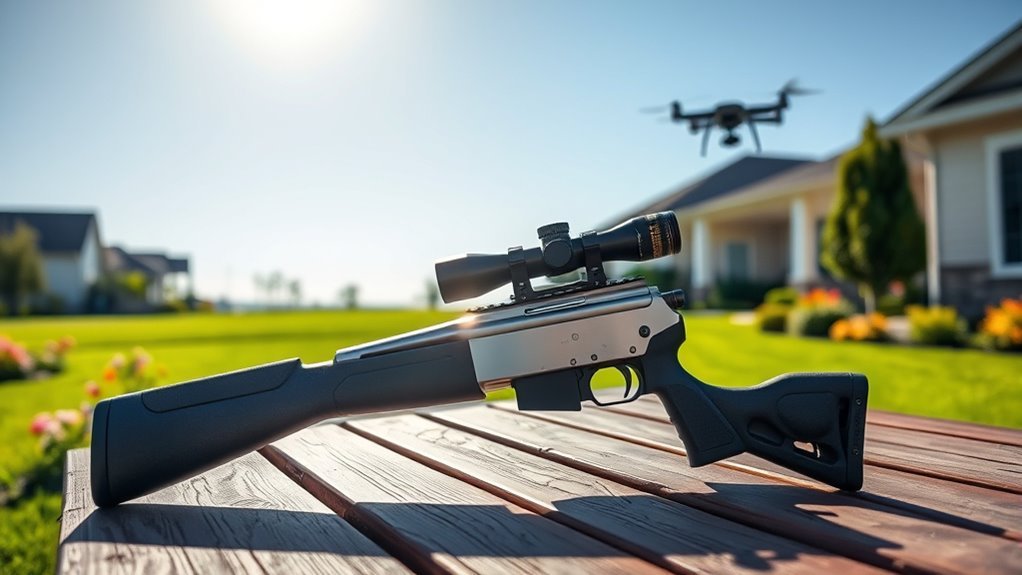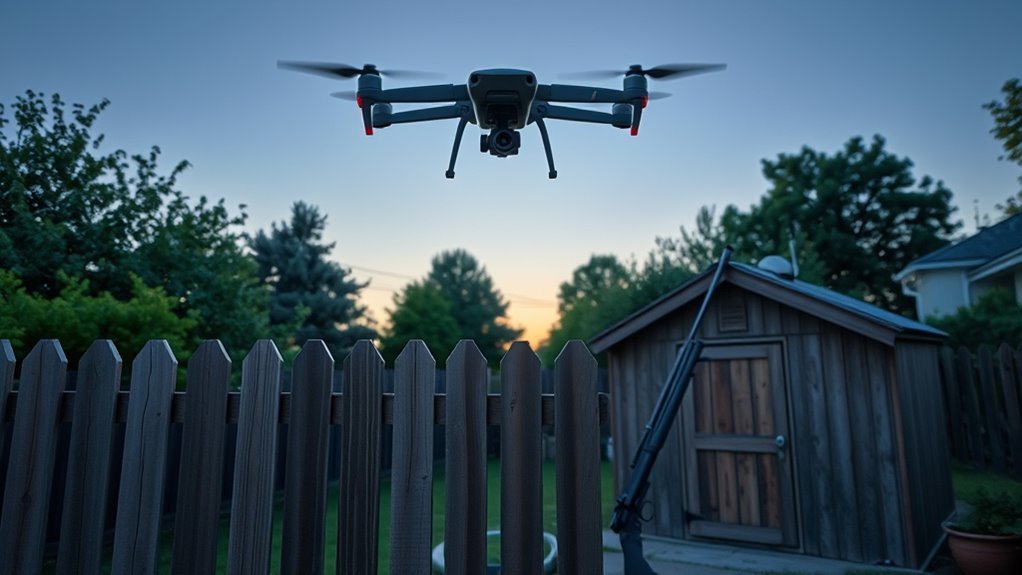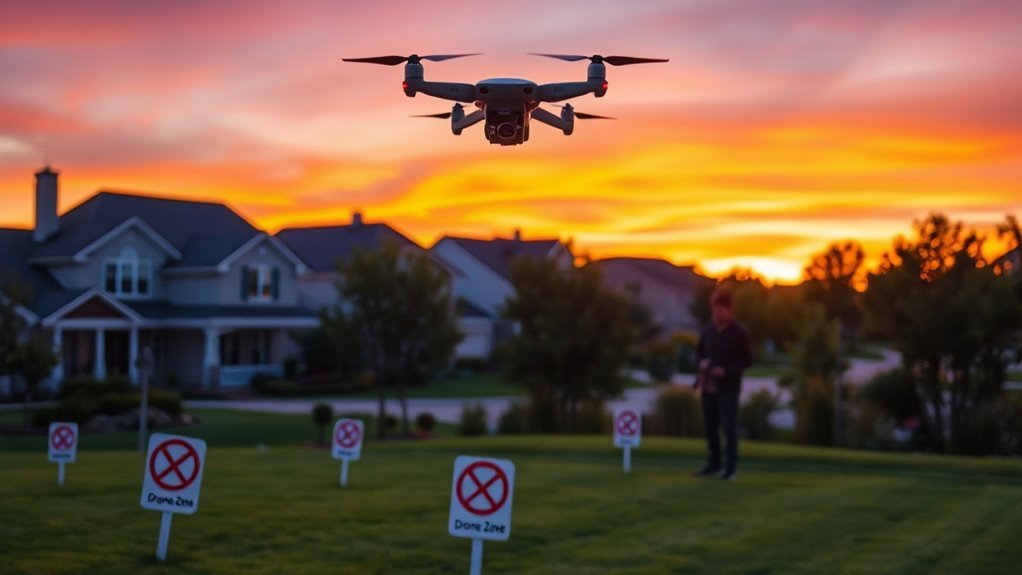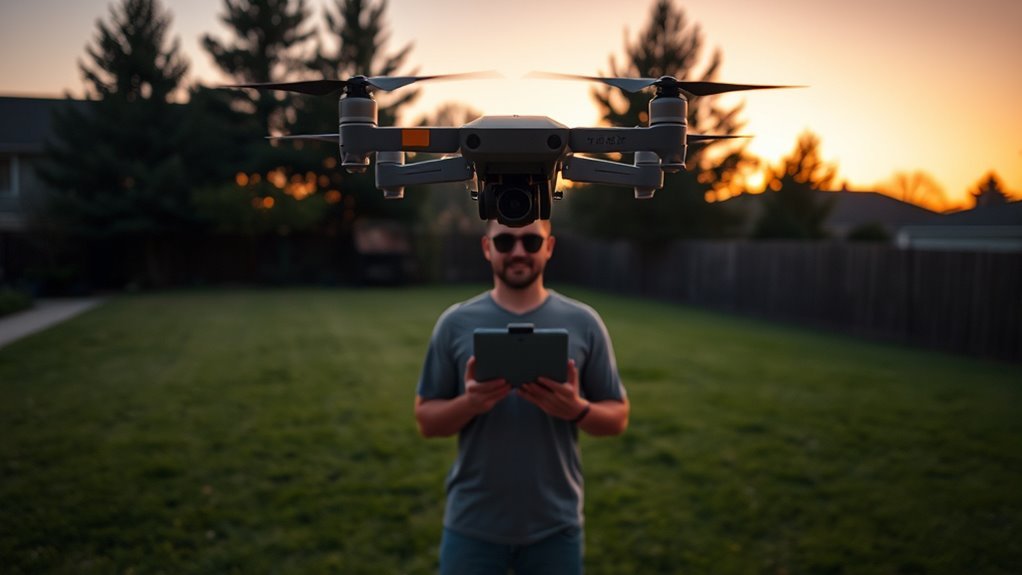You can’t legally shoot down drones flying over your property because federal laws prohibit damaging any aircraft, including drones. Property rights don’t extend unlimited airspace control, as the FAA regulates drone operations to guarantee safety. Shooting down a drone risks serious criminal charges and civil liability. Instead, document incidents and report unauthorized drones to local authorities. Understanding your rights and alternative legal steps can help protect your privacy while avoiding legal trouble. More guidance on managing drone issues is available here.
Understanding Drone Laws and Regulations

Why is it essential to understand drone laws before taking any action? Because acting without knowledge can lead to legal consequences that restrict your freedom rather than protect it. You need to recognize that drone trespassing laws vary by jurisdiction, and unauthorized interference with aerial surveillance could result in criminal charges. Familiarize yourself with federal and local regulations governing drone operations, including no-fly zones and privacy protections. Knowing these rules guarantees you respect lawful drone use while defending your rights responsibly. Your goal is to balance freedom with caution; shooting down a drone impulsively might escalate your situation legally. By thoroughly understanding drone laws and regulations, you can navigate this complex issue prudently, safeguarding your property without violating established legal boundaries.
Property Rights vs. Airspace Rights

You need to understand where your property boundaries end and how far your airspace rights extend. Legal precedents have clarified that while you own the land, your control over the airspace above is limited. Knowing these distinctions is essential before taking any action against drones flying overhead.
Defining Property Boundaries
Understanding the distinction between property rights and airspace rights is essential when considering how to deal with drones flying near your land. Your property lines clearly define your ownership on the ground, but these lines don’t automatically extend infinitely upward. This gray area often leads to boundary disputes, especially involving aerial intrusions. While you have full control within your property lines, the airspace above is subject to complex regulations. To protect your freedom effectively, you must first establish where your rights start and end. Carefully documenting your property boundaries helps clarify what is legally yours. Before taking any action against drones, recognize that airspace rights differ markedly from traditional property rights. This understanding is critical to guarantee your response remains lawful and respects the balance between personal freedom and public airspace.
Airspace Ownership Limits
Although property ownership grants you control over the land itself, it doesn’t extend indefinitely into the sky above. Your airspace ownership is limited by federal regulations that balance property rights with public air travel needs. Understanding these limits is essential before evaluating any action against drones invading your space.
Key points to keep in mind include:
- Property rights typically cover up to the height necessary for the land’s reasonable use.
- The Federal Aviation Administration (FAA) governs navigable airspace, which generally begins above 500 feet.
- Drones often operate below this threshold, creating a gray area in airspace ownership.
- Interfering with aircraft, including drones, can lead to significant legal consequences.
Navigating these boundaries carefully guarantees you protect your freedom without overstepping legal limits.
Legal Precedents on Drones
While the legal landscape surrounding drones is still evolving, several court cases have begun to clarify the balance between property rights and airspace regulations. You need to understand that courts generally recognize your right to privacy and protection against property encroachment but also acknowledge federally regulated navigable airspace. Legal precedents emphasize that drones flying at altitudes interfering with your reasonable use of property—such as hovering just feet above your land—may violate your rights, particularly concerning drone privacy intrusions. However, shooting down drones remains largely illegal under federal law, even if you feel your property is being encroached upon. Staying informed about these rulings helps you defend your freedoms responsibly while respecting evolving airspace laws designed to guarantee safety and privacy.
Federal Aviation Administration (FAA) Rules on Drones

Because drones operate within national airspace, the Federal Aviation Administration (FAA) strictly regulates their use to guarantee safety and security. You must understand these rules before considering any action against a drone. The FAA enforces:
- Mandatory drone registration requirements for all drones over 0.55 pounds.
- Restrictions on flying near airports and controlled airspace without prior authorization.
- Coordination with air traffic control to prevent interference with manned aircraft.
- Prohibitions against flying drones above 400 feet or beyond the visual line of sight.
Ignoring these regulations can lead to severe penalties. If a drone violates your property rights, your first step should be to verify compliance with FAA rules. Remember, the FAA’s authority aims to protect everyone’s freedom and safety in the skies. Taking matters into your own hands without understanding these rules risks legal consequences.
State and Local Laws Governing Drone Use
Beyond federal regulations, state and local governments have their own rules that can affect how drones are used and what actions you can legally take. You need to carefully review state regulations that may prohibit interfering with drones or define specific protections for private property. Local ordinances often add another layer, restricting drone flights over certain areas or establishing no-fly zones. These laws vary widely, so what’s legal in one place might be illegal just a few miles away. To protect your freedom while respecting the law, consult your state’s statutes and local ordinances before considering any action against drones. Understanding these regulations guarantees you don’t unintentionally violate the law, keeping your rights intact without exposing yourself to legal consequences.
Legal Risks of Shooting Down a Drone
You need to understand that federal regulations strictly prohibit unauthorized destruction of drones, regardless of your property rights. Even if a drone is flying over your land, shooting it down could expose you to serious criminal charges. Knowing these legal boundaries is essential before taking any action against a drone.
Federal Regulations Overview
Although drones can pose privacy or safety concerns, federal laws strictly regulate how you can respond to them. Understanding federal drone regulations is essential before taking any action. The airspace jurisdiction is federally controlled, meaning you don’t have the right to destroy drones simply because they’re over your property. Violating these laws could lead to severe penalties, including fines and criminal charges. Here’s what you need to know:
- The FAA governs all airspace below 400 feet, including drones.
- It’s illegal to damage or destroy any aircraft, including drones.
- You must comply with federal privacy and safety rules.
- Law enforcement handles drone violations, not private individuals.
Respecting these regulations protects your freedoms and keeps you on the right side of the law.
Property Rights Limitations
Even if a drone is flying over your property without permission, your rights to take direct action against it are extremely limited. While you have property ownership, this doesn’t guarantee full control of the airspace above your land. Aerial rights are complex and generally extend only to a reasonable height necessary for the use and enjoyment of your property—not unlimited vertical space. Federal aviation regulations further restrict your authority, making it clear that shooting down a drone can violate both airspace laws and property rights. You must recognize these limitations to avoid legal trouble. Instead of taking matters into your own hands, consider reporting unauthorized drone activity to the proper authorities who handle aerial regulation and enforcement. Your freedom is best protected by understanding these boundaries.
Potential Criminal Consequences
While it might seem tempting to take immediate action against a drone invading your airspace, shooting it down carries serious legal risks that you need to understand. You could face criminal charges or liability issues for damaging someone else’s property or interfering with federal regulations. Before acting, consider these potential consequences:
- Criminal charges for destruction of property or unlawful use of weapons
- Civil liability for damages caused to the drone or third parties
- Violations of FAA rules regulating airspace and drone operations
- Possible federal penalties if the drone is government-operated or used for emergency services
Understanding these risks helps protect your freedom without crossing legal boundaries. Always exhaust legal remedies before considering any forceful measures against drones.
Alternative Legal Actions to Take Against Intrusive Drones
Because directly disabling or shooting down drones is often illegal and risky, you should consider alternative legal actions to address intrusive drone activity. If you’re facing drone harassment or privacy invasion, first establish clear evidence of the intrusion without taking physical action. Notify local law enforcement or your municipality, as many regions have specific regulations protecting citizens from unauthorized drone surveillance. You can also explore civil remedies, such as filing a nuisance claim or seeking an injunction to prevent further drone flights over your property. Engaging with community groups or advocacy organizations can help push for stronger drone privacy laws that safeguard your freedom. Always prioritize legal channels to protect your rights while avoiding actions that could expose you to criminal liability or escalate conflicts.
How to Document and Report Drone Incidents
When you encounter a drone incident, documenting every detail accurately is essential to building a strong case for authorities or legal action. Effective incident logging guarantees your concerns are taken seriously and protects your rights.
For thorough drone reporting, focus on:
- Recording the date, time, and location of the incident
- Describing the drone’s appearance, behavior, and any identifying marks
- Capturing video or photos if safe and legal to do so
- Noting any interactions or responses from the drone operator
Keep your records organized and submit them promptly to local law enforcement or relevant agencies. Accurate documentation strengthens your position while respecting legal boundaries, empowering you to defend your property and privacy responsibly.
The Role of Privacy Laws in Drone Encroachment
Though drones offer innovative uses, their ability to capture images and data raises significant privacy concerns. As you seek to protect your property, understanding privacy expectations is vital. Laws vary, but generally, drone operators must respect your reasonable expectation of privacy—meaning they cannot legally conduct drone surveillance where you’d expect solitude, like inside your home or fenced yard. However, public spaces or visible areas may have fewer protections. Violations of these privacy boundaries can be actionable, but it’s important to know the specific statutes in your jurisdiction. Your right to freedom includes safeguarding your privacy, but you must also guarantee any response aligns with legal limits. Being informed about privacy laws helps you address drone encroachment responsibly and effectively.
Consulting Legal Experts Before Taking Action
Before taking any measures against drones that invade your privacy or property, you should consult legal experts to confirm your actions comply with applicable laws. Utilizing professional consultation services guarantees you fully understand the legal implications of shooting down a drone. You must avoid actions that could expose you to criminal charges or civil liability. Legal experts can help you:
Consult legal experts before acting against drones to ensure compliance with laws and avoid liability.
- Interpret federal, state, and local drone regulations
- Assess the risk of infringing on airspace laws
- Understand your rights versus drone operators’ rights
- Develop a strategy that protects your freedom without breaking the law

